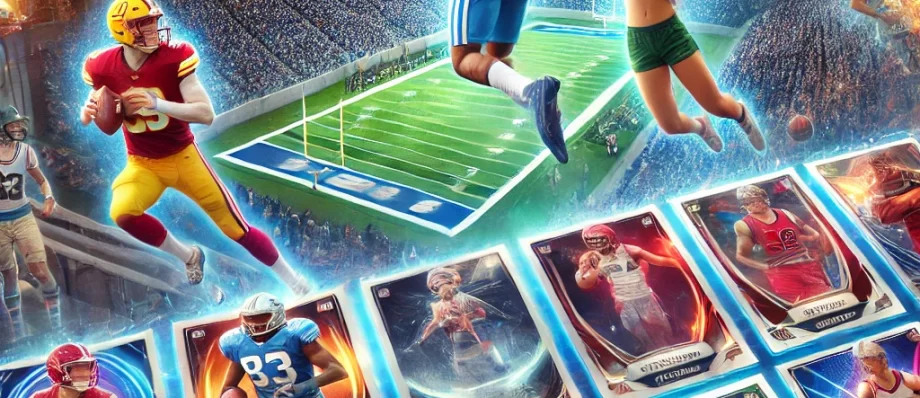The Impact of NIL Deals on Collegiate Sports Cards
A New Era for College Athletes and Collectors Alike
In July 2021, three simple letters—NIL—flipped the world of college sports on its head. With the NCAA’s long-standing amateurism rules finally loosening, student-athletes were granted the right to profit from their Name, Image, and Likeness. At first, the headlines focused on social media sponsorships, local car dealership ads, and protein shake endorsements. But beneath the surface, a quieter revolution was brewing: college athlete trading cards.
Now, in 2025, what began as a niche opportunity has blossomed into one of the most dynamic, fast-growing sectors in the sports card industry. And its implications are far-reaching—not just for collectors and investors, but for the very culture of college athletics.
The Rise of Collegiate Cards: From Hype to Legitimate Market
Before NIL, college trading cards were largely limited to school-specific releases, oddball sets, or post-career draft cards. Today, companies like Topps, Panini, and Leaf are signing athletes directly, producing licensed sets while players are still wearing their college uniforms.
This shift has led to:
- First Bowman-style cards for NCAA football and basketball stars
- Autographed cards and relics from college games
- On-demand drops tied to individual performances and milestones
Collectors are no longer waiting for a player to go pro before jumping in. In many ways, NIL-era collegiate cards have become the new prospecting frontier—a blend of pre-rookie speculation and die-hard school loyalty.
Building a Brand, One Card at a Time
These cards aren’t just collectibles—they’re brand-building platforms. Athletes like Arch Manning, Caitlin Clark, and Marvin Harrison Jr. have capitalized on NIL deals that include exclusive trading card contracts. For many athletes, this marks their first exposure to national audiences, even before stepping onto a professional stage.
For card manufacturers, the opportunity is enormous. College fans are fiercely loyal, and collectors aligned with programs like Alabama football or UConn women’s basketball are eager to grab cards of their favorite players in school colors. It’s a rare trifecta: athletes earn, collectors collect, and brands expand.
Risks and Rewards for the Modern Collector
While NIL collegiate cards present exciting opportunities, they also come with uncertainty:
- High volatility: A five-star recruit might underperform or transfer, cratering card values overnight.
- Short-lived hype: Many college stars spend just one season in the limelight before turning pro or losing relevance.
- Licensing limitations: Not all cards are officially licensed with schools, which can affect design, desirability, and long-term value.
Still, the upside is substantial. Savvy collectors who invested early in athletes like Caleb Williams or Angel Reese are already seeing impressive returns. This is a market that rewards knowledge, timing, and a little gut instinct.
Leveling the Playing Field: Equity and Access
The NIL trading card movement isn’t just about profits—it’s about representation and access. For decades, only professional athletes were immortalized on cardboard. Now, a college volleyball player, gymnast, or track star can have their own trading card—and be compensated for it.
This evolution has opened the door to:
- Women’s sports, which are finally receiving the attention they deserve in the collectibles space
- Non-revenue sports, whose athletes have devoted fan bases and unique appeal
- HBCUs and smaller programs, whose stars now reach collectors on a national level
It’s a long-overdue democratization of the hobby.
What’s Next for NIL and the Hobby?
As the NIL ecosystem matures, several trends are on the horizon:
- Increased integration of digital collectibles and NFTs for college athletes
- Athlete-controlled merchandise, including personal card lines and branding efforts
- Expanded licensing deals that bring more schools into officially branded sets
- Cross-platform branding, as trading cards tie into social media presence, merchandise, and even video games
And don’t be surprised if college-focused grading becomes a bigger deal, with pre-draft cards someday rivaling pro rookie cards in prestige.
Conclusion: The Future is Now
NIL didn’t just change the financial future of college athletes—it changed the game for collectors, too. Collegiate trading cards have emerged as a vibrant new space, fusing the thrill of early prospecting with the passion of college sports fandom.
Whether you’re an investor, a lifelong fan, or just someone who appreciates the journey of an underdog, NIL-era cards offer something special: a chance to collect the present before it becomes the future.
So don’t sleep on that freshman phenom—his (or her) card might just be the next big thing.








